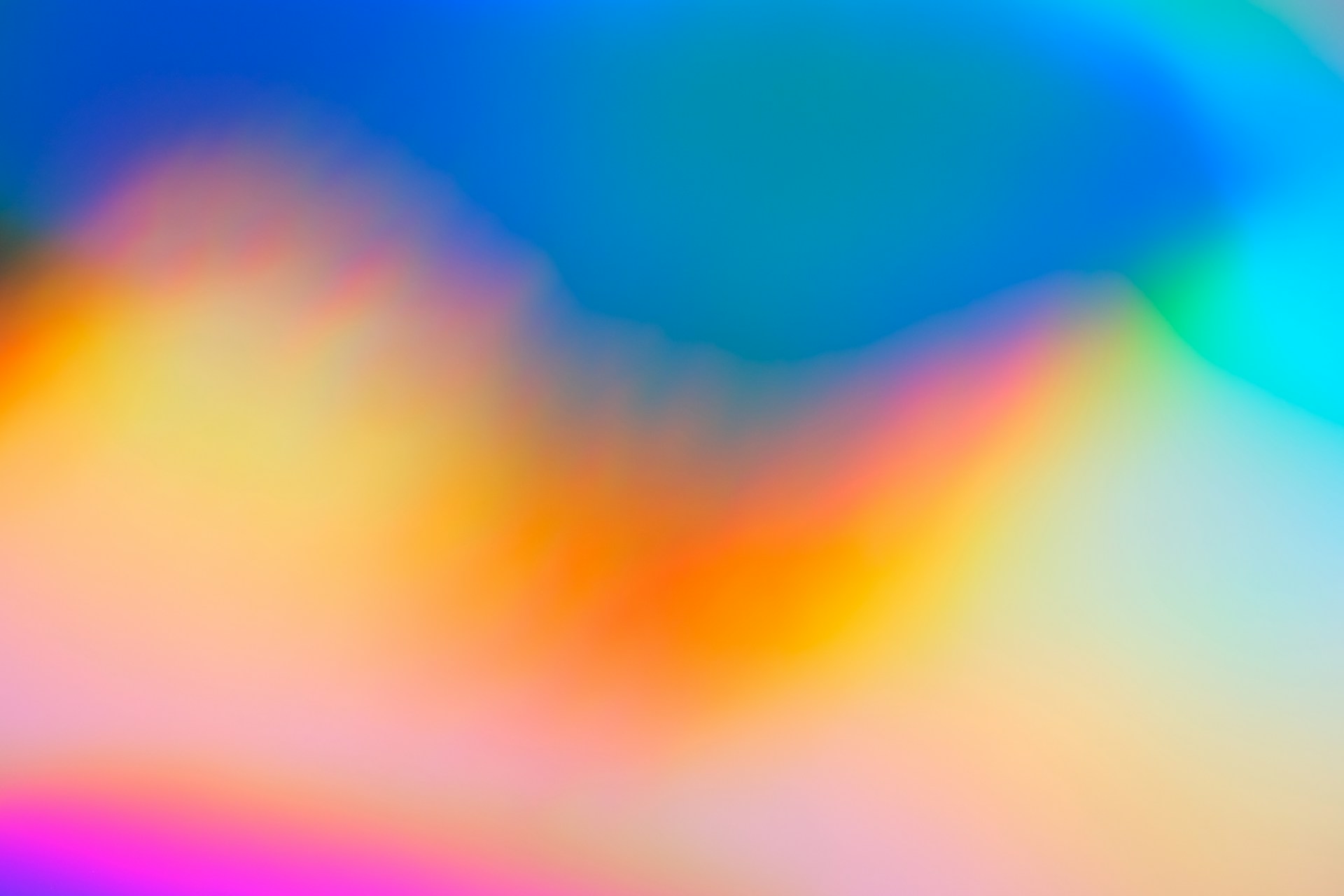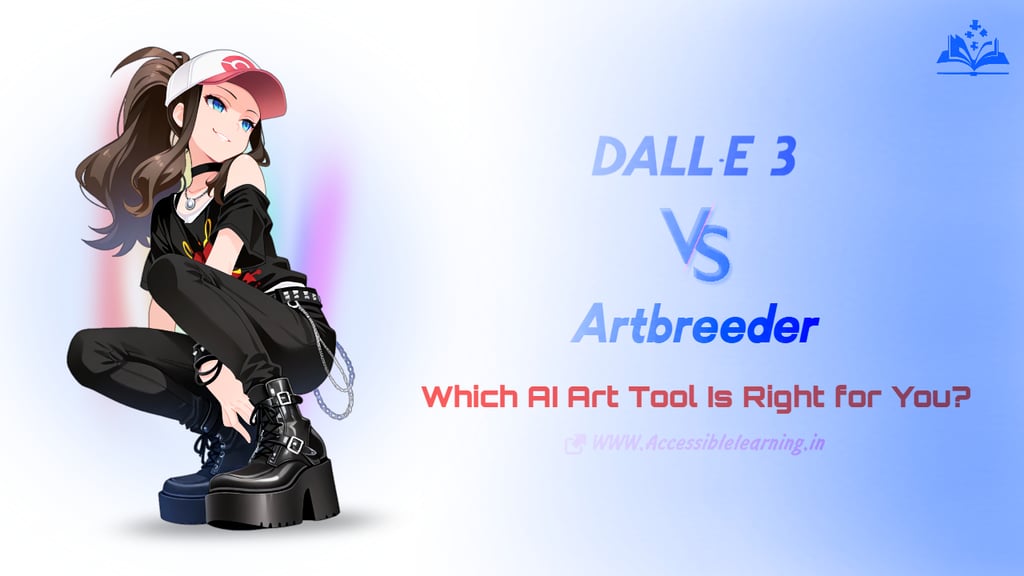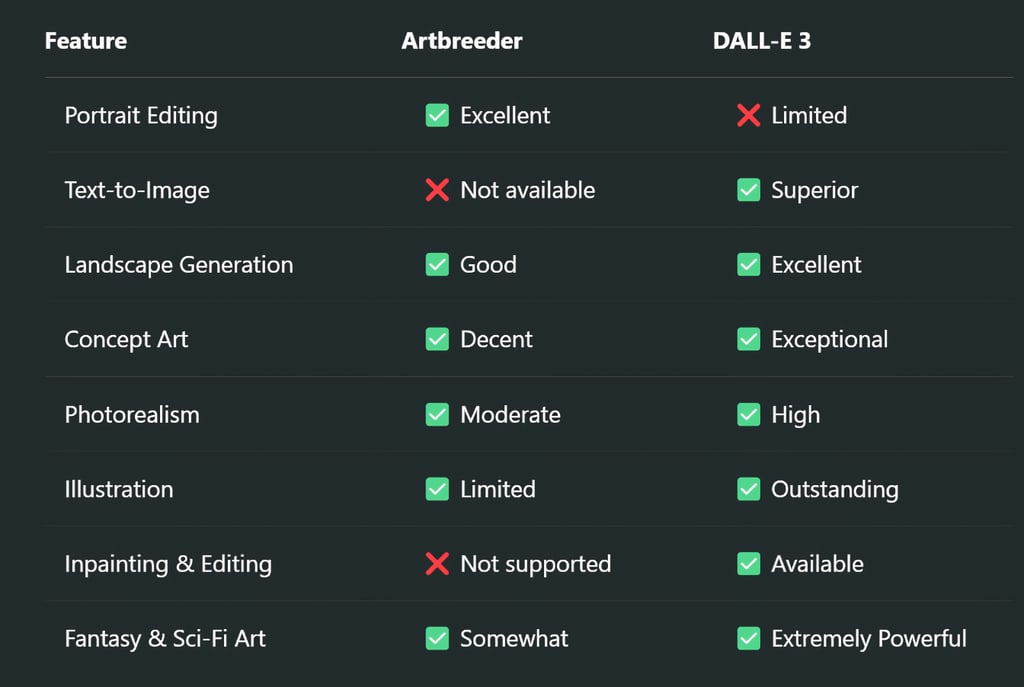
Artbreeder vs DALL-E 3: Which AI Art Generator Stands Out?
Explore the in-depth comparison between Artbreeder and DALL-E 3—two powerful AI art generators. Discover their features, differences, use cases, and which one best suits your creative needs!
AI ART TOOLSEDITOR/TOOLSAI/FUTUREARTIST/CREATIVITY
Sachin K Chaurasiya
4/10/20254 min read


In the rapidly evolving world of AI-generated art, Artbreeder and DALL-E 3 have emerged as two powerful tools for artists, designers, and creatives. But how do they compare? While both platforms use artificial intelligence to generate stunning visuals, their approaches, customization levels, and intended use cases differ significantly.
In this detailed comparison, we'll explore how Artbreeder and DALL-E 3 function, their strengths, limitations, and which one might be the best fit for your creative needs.
What is Artbreeder?
Artbreeder is an AI-powered tool that allows users to create and modify images using a collaborative, genetic algorithm approach. It is primarily focused on blending and evolving existing images, allowing users to tweak features such as facial expressions, age, and artistic style through interactive sliders.
Key Features
Image blending: Users can merge multiple images to generate new variations.
Facial customization: Modify facial features, gender, and expressions.
Artistic collaboration: A community-driven approach where users refine and improve each other's work.
Landscapes and abstract art: Supports non-human subjects like landscapes and abstract compositions.
Style control: Users can select from different artistic styles, including anime, fantasy, realism, and more.
High-resolution downloads: Allows saving images in high-quality formats for use in digital projects.
Strengths
Interactive customization: Sliders for facial features, age, gender, expression, etc.
Blending capability: Easily combines multiple images into new visuals.
Collaborative community: Shared edits and remixing allow for evolving artwork.
Great for portraits and landscapes: Especially strong in stylized human faces and dreamy environments.
Ease of use: Beginner-friendly visual interface.
Weaknesses
Limited originality: Can’t generate images from scratch; depends on existing data.
Lower resolution by default: Requires a subscription for high-res downloads.
Narrow subject range: Not ideal for non-human, fantastical, or ultra-realistic art.
No inpainting/editing: Can’t modify parts of images like DALL-E can.
Limited style variation: May feel repetitive after extended use.
Best for
Artists looking to refine and generate creative variations of portraits, landscapes, and abstract designs through an intuitive interface.
What is DALL-E 3?
DALL-E 3, developed by OpenAI, is an advanced text-to-image AI model that can generate highly detailed and imaginative artwork from textual descriptions. Unlike Artbreeder, which focuses on evolving existing images, DALL-E 3 creates entirely new ones based on prompts.
Key Features
Text-to-image generation: Users can create unique images simply by describing what they want.
High-quality, realistic outputs: Capable of producing photorealistic and highly detailed artwork.
Creative freedom: Generates anything from fantastical creatures to professional-grade illustrations.
Integration with ChatGPT: Offers interactive prompt refinement to help users describe their vision effectively.
Advanced understanding of prompts: Can process highly specific or abstract concepts, creating intricate and layered compositions.
Editing and inpainting: Allows modifying parts of an image through additional prompts.
Strengths
Text-to-image generation: Creates images from any natural language prompt.
Highly creative & versatile: Can visualize abstract, surreal, or imaginary scenes.
Advanced understanding of language: Handles complex and nuanced descriptions well.
Inpainting/editing capabilities: Modify or regenerate specific parts of an image.
Wide style range: From photorealism to anime to oil painting.
Weaknesses
Prompt dependency: Output quality depends heavily on how well the prompt is crafted.
Less direct control: Users can’t tweak specific features easily after image generation.
Occasional inaccuracies: May misinterpret overly complex or ambiguous prompts.
Requires computing power or API: Some features are locked behind paywalls or APIs.
Best for
Users looking to create unique, high-quality images from scratch using natural language descriptions.


Comparison: Artbreeder vs DALL-E 3
Customization & Control
Artbreeder offers interactive control over image elements through sliders, allowing users to modify aspects like facial features and artistic styles gradually. It's great for fine-tuning details but doesn't generate new concepts from scratch.
DALL-E 3 provides natural language-based customization, allowing for infinite possibilities in image generation. However, fine-tuning specific aspects of an image can sometimes be less precise than Artbreeder’s approach.
Artbreeder offers limited direct control over small details, whereas DALL-E 3 can regenerate specific sections using inpainting.
Winner: Depends on the need—Artbreeder for controlled refinements, DALL-E 3 for broad creative freedom.
Image Generation Process
Artbreeder requires an existing image or a mix of multiple images to generate results. Users guide the process by adjusting elements, making it more of an evolutionary approach to art creation.
DALL-E 3 starts with a blank canvas and builds an image entirely from the text prompt, making it perfect for original concept creation.
DALL-E 3 can generate entirely new ideas, including things that don’t exist in reality, whereas Artbreeder is limited to working within the constraints of blended images.
Winner: DALL-E 3 for originality, Artbreeder for iterative improvements.
Ease of Use
Artbreeder is highly intuitive for users who prefer visual sliders and a guided creative process.
DALL-E 3 is easy for anyone who can describe what they want, but crafting effective prompts may require some trial and error.
Artbreeder’s workflow is more predictable, while DALL-E 3 can sometimes produce unexpected results depending on prompt complexity.
Winner: Tie—Artbreeder for slider-based control, DALL-E 3 for natural language interaction.
Artistic vs. Realistic Output
Artbreeder leans towards a blend of realism and abstraction, often producing dreamlike or stylized portraits and landscapes.
DALL-E 3 can generate hyper-realistic images as well as surreal, abstract, and illustrative works based on prompts.
DALL-E 3 provides better diversity in artistic styles, ranging from oil paintings to 3D renders.
Winner: DALL-E 3 for diverse styles, Artbreeder for stylized artistic refinements.


Which One Should You Choose?
Choose Artbreeder if: You enjoy refining existing visuals, blending faces, landscapes, and abstract images, and prefer hands-on adjustments.
Choose DALL-E 3 if: You want to generate images from text prompts, need high-quality original artwork, or want a broader range of creative possibilities.
Use both if: You want to generate initial ideas in DALL-E 3 and refine them in Artbreeder.
Both tools have their strengths, making them valuable for different creative workflows. If you’re an artist who loves tweaking details, Artbreeder is your playground. If you’re looking for AI to bring your imagination to life instantly, DALL-E 3 is the way to go.
AI-driven art is revolutionizing the way we create, and both Artbreeder and DALL-E 3 offer unique benefits. While Artbreeder is great for controlled creativity and artistic refinement, DALL-E 3 is an open-ended tool for original image generation. Depending on your creative goals, you may even find value in using both together!
What’s your take? Which AI tool best suits your artistic needs? Let us know in the comments!
Subscribe To Our Newsletter
All © Copyright reserved by Accessible-Learning Hub
| Terms & Conditions
Knowledge is power. Learn with Us. 📚


